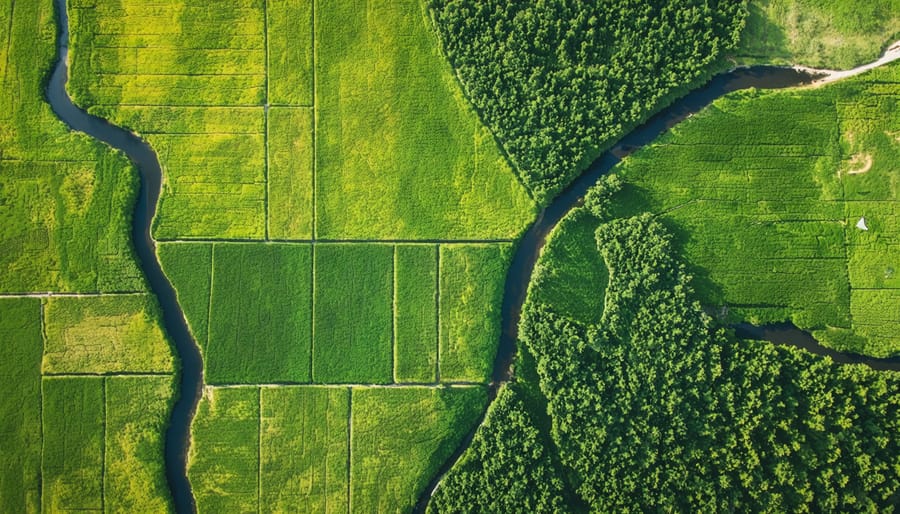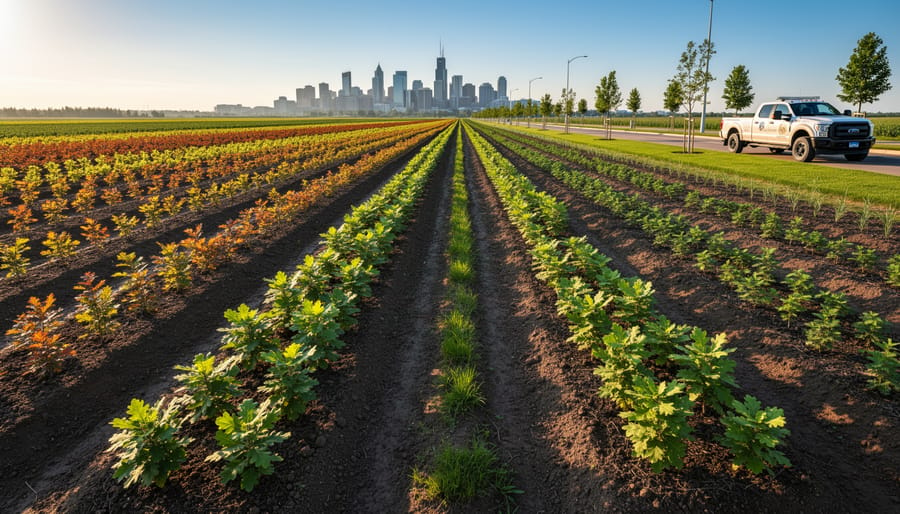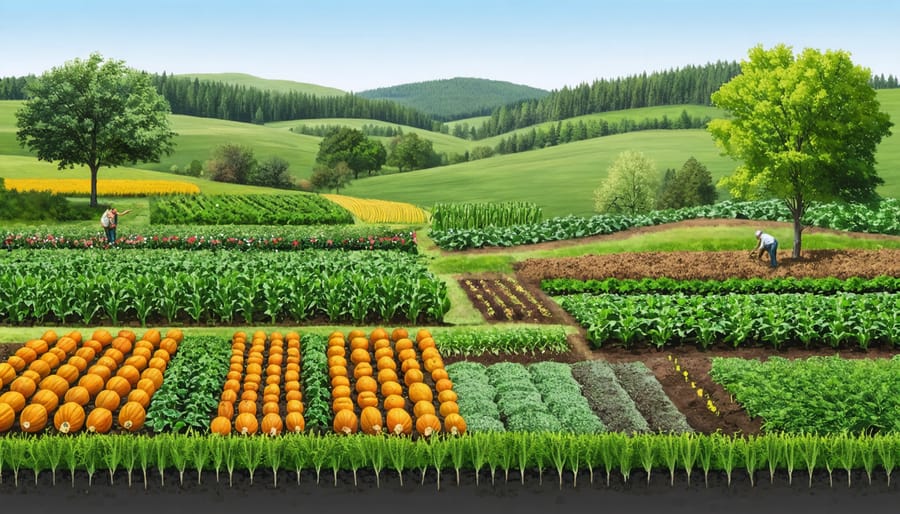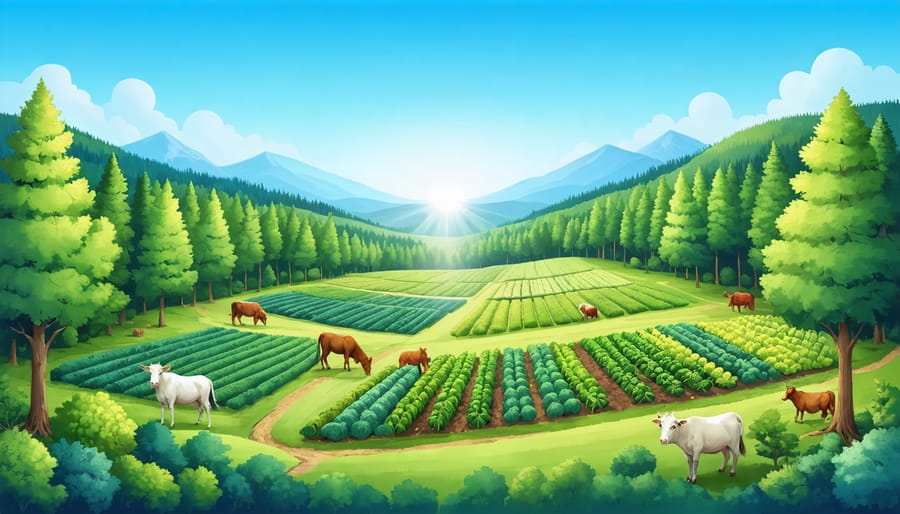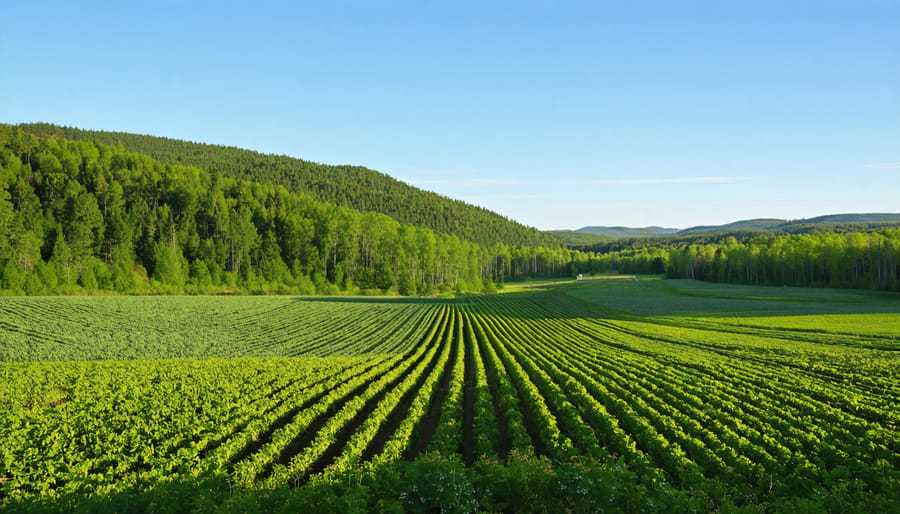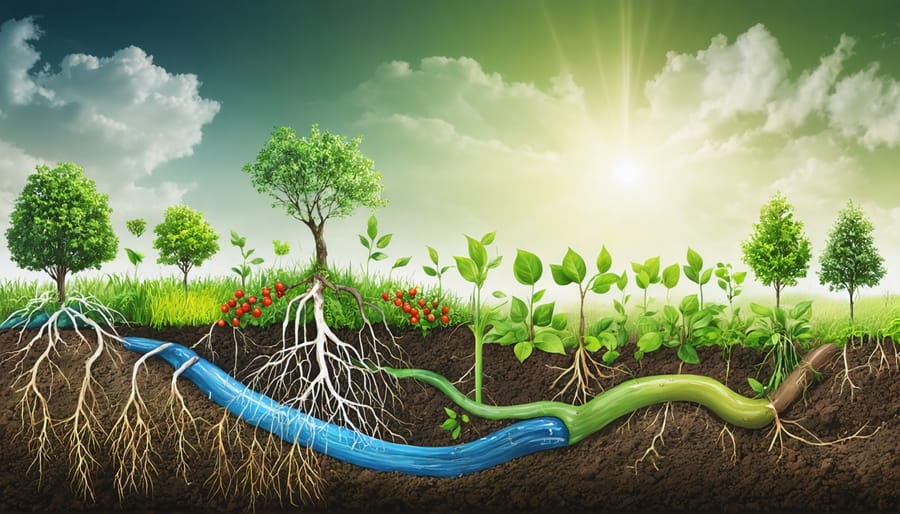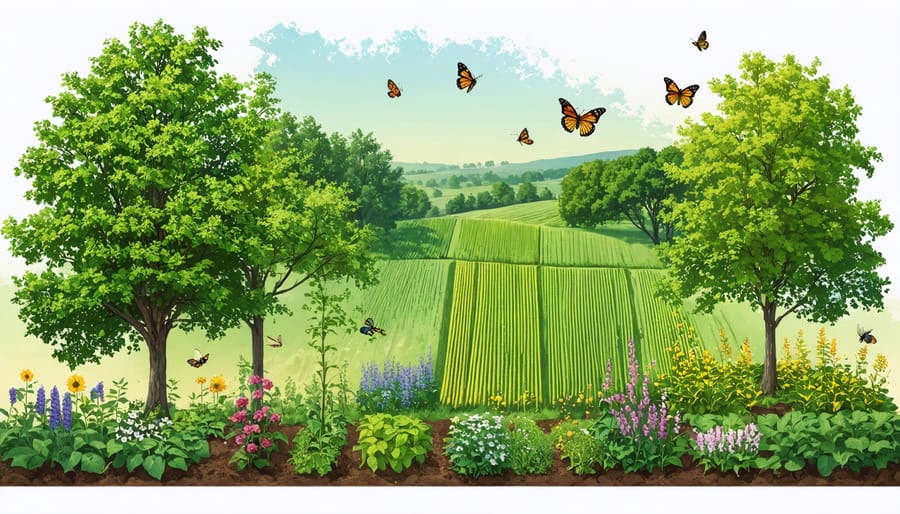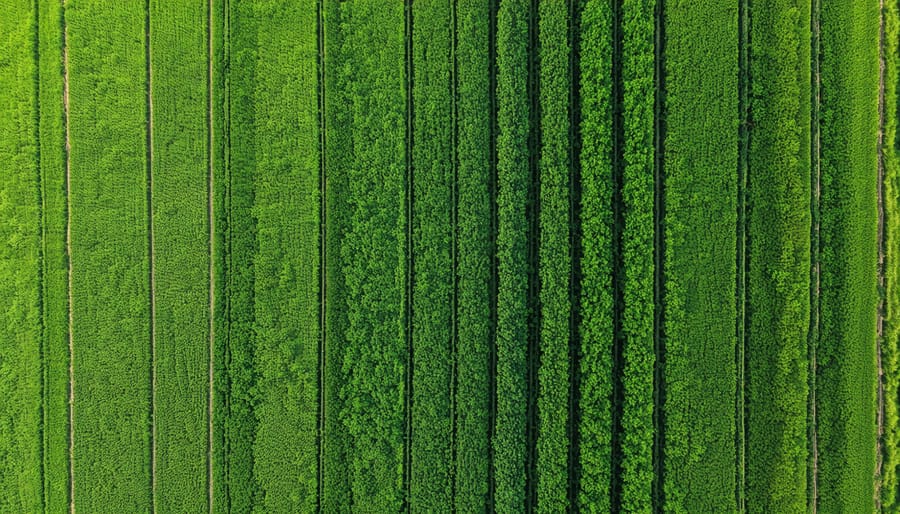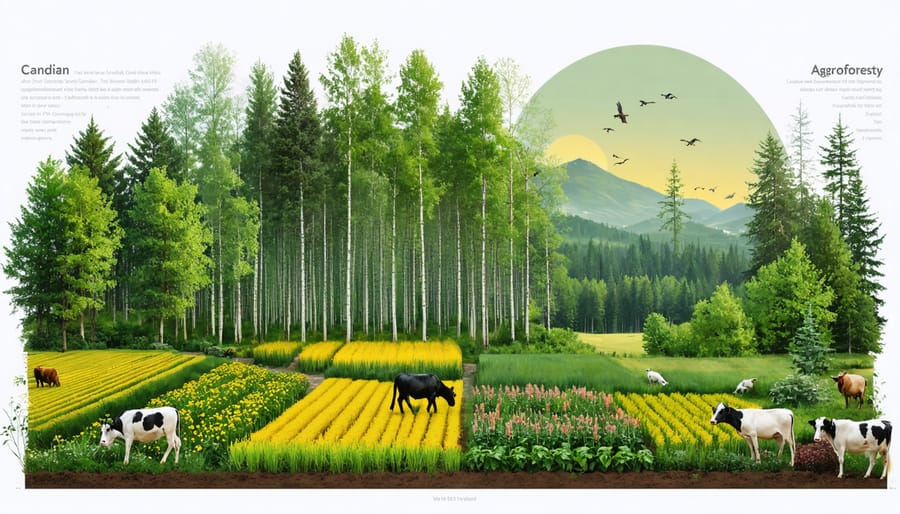In the heart of Alberta’s agricultural landscape, forests and water systems create a powerful synergy that’s reshaping modern farming practices. As climate patterns shift and water management becomes increasingly critical, the strategic integration of forest elements into agricultural operations offers a proven solution for sustainable water conservation.
Indigenous communities have long understood this vital connection, managing these resources together for generations across Canada’s vast territories. Today, innovative farmers throughout Alberta are rediscovering these principles, implementing agroforestry systems that naturally regulate water flow, reduce erosion, and create resilient microclimates.
The relationship between forests and water extends beyond simple conservation. Healthy forest systems act as natural water filters, with root networks that stabilize soil structure and improve water retention by up to 40%. For agricultural operations, this translates to reduced irrigation needs, enhanced drought resistance, and improved crop yields – critical advantages in Alberta’s variable climate.
Whether you’re managing a small family farm or overseeing large-scale agricultural operations, understanding this fundamental connection between forests and water systems opens new possibilities for sustainable resource management. By adopting integrated forest-water management strategies, Alberta’s farmers are pioneering approaches that protect both environmental and economic interests for future generations.
The Natural Partnership: Trees and Water Systems
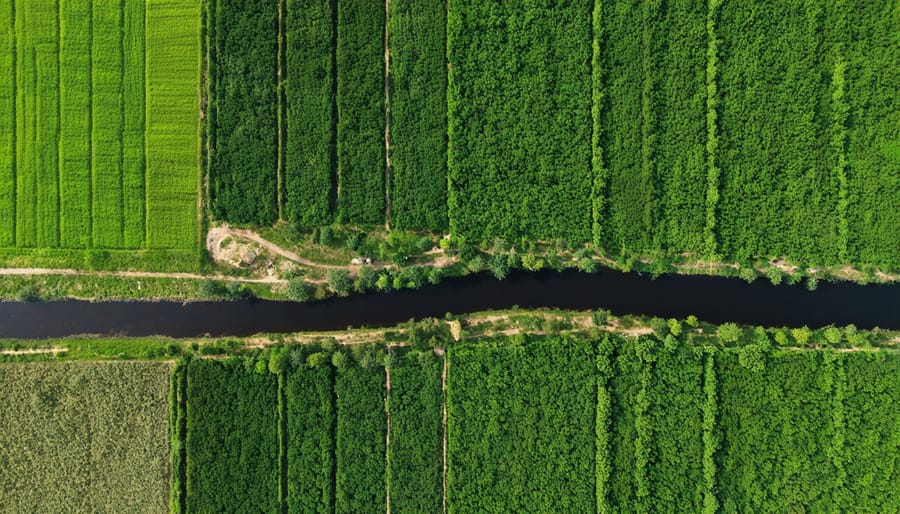
Water Retention and Soil Health
Trees play a vital role in maintaining healthy soil ecosystems and water management on agricultural lands. Their extensive root systems improve soil structure by creating channels that allow water to penetrate deeper into the ground, reducing surface runoff and erosion.
Here in Alberta, where moisture conservation is crucial, trees act as natural water reservoirs. Their leaf litter and organic matter increase the soil’s ability to hold water, typically storing 40% more moisture than open fields. This additional water-holding capacity can mean the difference between crop survival and failure during our dry spells.
The relationship between trees and soil health works both ways. As trees enhance soil structure, the improved soil quality allows for better water infiltration and storage. This creates a positive feedback loop that benefits both the forest and surrounding agricultural areas. For example, studies in central Alberta have shown that fields with shelterbelts retain up to 30% more soil moisture during critical growing periods.
Through their deep root systems, trees also help maintain groundwater levels and prevent soil compaction, ensuring long-term soil health and productivity for generations of Alberta farmers.
Natural Filtration Systems
Forests serve as nature’s most efficient water filtration systems, working tirelessly to purify our water resources here in Alberta. As rainfall moves through the forest canopy and into the soil, multiple natural processes work together to clean and filter the water. Tree roots, along with beneficial fungi and soil microorganisms, form an intricate underground network that traps sediments and filters out pollutants.
The forest floor, with its rich layer of organic matter and leaf litter, acts like a giant sponge. This natural filtering system removes up to 80% of sediments and contaminants before water reaches our streams and aquifers. In the Bow River watershed, for example, our forested areas significantly reduce the need for costly water treatment downstream.
The cycling of nutrients in forest ecosystems is equally impressive. As leaves decompose, they release essential nutrients that are captured and stored in the soil. This process not only enriches the soil but also prevents excess nutrients from entering waterways, which helps maintain water quality. For Alberta farmers, maintaining woodlots or shelterbelts can provide similar water purification benefits on a smaller scale, protecting both groundwater and surface water resources.
Strategic Forest Integration for Alberta Farms
Riparian Buffers
Riparian buffers, those strips of trees and vegetation along waterways, are one of the most effective tools for protecting water quality while enhancing farm biodiversity. Here in Alberta, farmers are discovering that maintaining these natural filters between cropland and water bodies pays dividends in multiple ways.
A well-designed riparian buffer typically extends 10 to 30 metres from the water’s edge, consisting of three zones: trees closest to the water, shrubs in the middle, and grasses nearest to crops. This layered approach creates a natural filtering system that captures up to 85% of sediment and nutrients before they reach the water.
For Alberta farmers, these buffers provide practical benefits beyond water protection. They stabilize banks, prevent erosion during spring runoff, and create windbreaks that protect crops. During heavy rains, these zones act like sponges, reducing flood risks and maintaining steady water flow during drier periods.
Local success stories show that cattle producers who implement riparian buffers see improved herd health, as these areas provide natural shade and shelter. Additionally, these zones create valuable wildlife corridors, supporting beneficial insects and birds that help with natural pest control.
Consider starting small by establishing a 10-metre buffer on one section of your waterway. Connect with your local watershed group for native plant recommendations and potential cost-share programs that can help offset implementation costs.
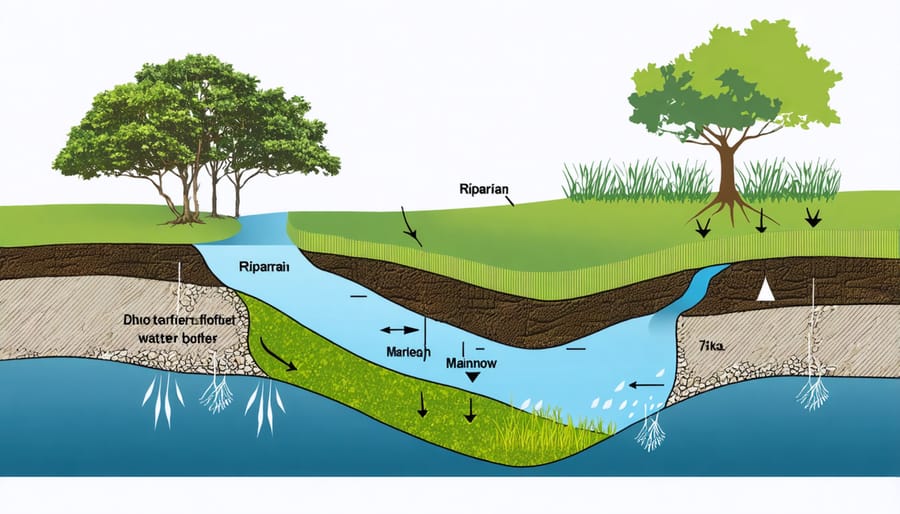
Windbreak Systems
Windbreak systems are one of the most effective tools Alberta farmers can use to protect their water resources and enhance agricultural productivity. These strategically placed rows of trees and shrubs create natural barriers that significantly reduce wind speed and evaporation rates across fields and water bodies.
On the prairies, where wind can be particularly challenging, properly designed windbreaks can reduce evaporation by up to 30% in protected areas. This means more water stays where it’s needed – in your soil and dugouts. Local farmer Mike Thompson from Red Deer County shares, “Since installing our three-row windbreak system five years ago, we’ve noticed our dugout water levels remain more stable throughout the summer months.”
When planning your windbreak, consider using a mix of native species like white spruce, green ash, and caragana. These hardy varieties are well-adapted to our climate and provide year-round protection. For optimal results, plant your windbreak perpendicular to prevailing winds, typically on the north and west sides of water sources.
The benefits extend beyond water conservation. Windbreaks also trap snow during winter months, creating natural moisture reservoirs for spring. Many Alberta producers report improved crop yields in fields protected by windbreaks, with the greatest benefits seen within 10-15 times the height of the trees downwind.
Remember to maintain adequate spacing between trees and provide regular maintenance in the first few years to ensure strong establishment. Your local agricultural fieldman can provide specific recommendations for your area.
Forest-Based Irrigation Design
In Alberta’s diverse landscape, existing forest patches can be powerful allies in creating efficient irrigation systems. By strategically incorporating these natural features into your farm’s water management plan, you can enhance water retention and distribution while maintaining ecological balance.
Natural forest areas act as water filters and regulators, helping to slow water movement and reduce erosion. When planning irrigation systems, consider positioning water channels and retention ponds near existing woodlots to take advantage of their natural water-holding capacity. The tree root systems help maintain soil structure and create natural pathways for water infiltration.
Many Alberta farmers have found success by designing their irrigation layouts to follow the natural contours of forested areas. For example, the Morrison family farm near Red Deer reduced their irrigation costs by 30% after integrating their sprinkler system with existing aspen groves, which helped regulate water flow and reduce evaporation losses.
To implement forest-based irrigation effectively, start by mapping existing forest patches on your property. Consider factors like slope, soil type, and seasonal water patterns. Work with local agricultural extension services to develop a plan that maximizes the benefits of your forested areas while meeting your crops’ water needs.
Remember to maintain buffer zones between irrigated areas and forest edges to protect tree health and prevent root damage. Regular monitoring of soil moisture levels near forest boundaries can help optimize your irrigation schedule and prevent overwatering.
Real Success Stories: Alberta Farmers Leading the Way
The Robertson Family Farm
Located just outside of Red Deer, Alberta, the Robertson Family Farm stands as a testament to innovative water conservation through strategic forest management. When Sarah and Mike Robertson inherited their 300-hectare farm in 2015, they faced significant challenges with water retention and soil erosion during spring runoff.
The Robertsons implemented a comprehensive forest management plan that transformed their operation. They established strategic windbreaks using native species like white spruce and trembling aspen, creating natural snow traps that increased spring moisture retention by 40%. These forested areas now help regulate water flow across their property, reducing erosion and improving soil health.
“The difference in our water management since establishing these forest zones has been remarkable,” shares Sarah Robertson. “We’ve cut our irrigation needs by nearly a third, and our soil moisture levels remain more consistent throughout the growing season.”
The family also integrated riparian buffers along their creek system, planting willows and other water-loving species. This initiative not only protected their water source but also created valuable wildlife habitat. Their success has inspired neighbouring farms to adopt similar practices, leading to the formation of a local watershed stewardship group.
The Robertson’s approach demonstrates how thoughtful forest integration can create a more resilient agricultural system. Their annual field days now draw farmers from across Alberta, eager to learn about their water-smart forestry practices.
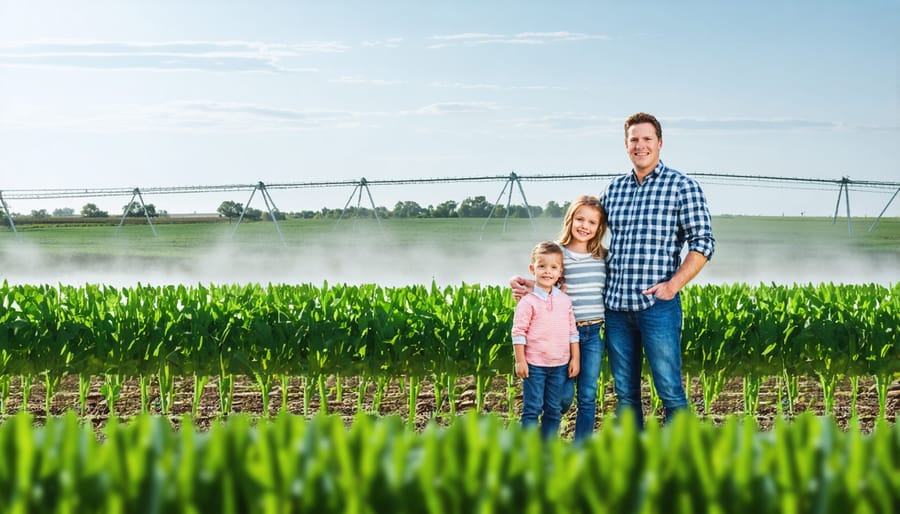
Clearwater Valley Cooperative
The Clearwater Valley Cooperative stands as a shining example of how Alberta’s farming communities are successfully integrating forest management with water conservation. Established in 2018 by a group of 15 local farmers, this innovative project has transformed over 2,000 hectares of agricultural land into a thriving forest-water ecosystem.
Members of the cooperative work together to maintain forested buffer zones along waterways, sharing both the responsibilities and benefits of this integrated approach. The results have been remarkable, with participating farms reporting a 30% reduction in irrigation needs and significant improvements in soil moisture retention.
“We’ve seen dramatic changes in water quality and availability since implementing our forest management plan,” says Sarah Thompson, a third-generation farmer and founding member of the cooperative. “The trees act like natural water filters and help regulate our water supply throughout the growing season.”
The cooperative’s success stems from its community-based approach, where members pool resources and knowledge. They’ve developed a rotating maintenance schedule that ensures proper care of the forested areas while distributing the workload evenly among participants. Regular workshops and knowledge-sharing sessions help members stay updated on best practices and new techniques.
The initiative has become a model for other farming communities across Alberta, demonstrating how collective action can lead to sustainable water management while maintaining productive agricultural operations. The cooperative’s approach has been particularly effective during dry seasons, with member farms showing greater resilience to drought conditions compared to neighboring properties.
Getting Started: Practical Steps for Your Farm
Assessment and Planning
Before implementing a forest and water management system on your farm, it’s essential to conduct a thorough assessment of your current resources and develop a detailed plan. Start by mapping your property, identifying existing water sources, drainage patterns, and areas prone to erosion or water accumulation. Consider conducting soil tests to understand water retention capabilities and nutrient levels.
Work with local agricultural extension officers to evaluate your property’s specific needs and potential. They can help you assess implementation costs and considerations while ensuring compliance with local regulations.
Create a timeline that accounts for seasonal variations typical to Alberta’s climate. Your plan should include:
– Species selection based on local conditions
– Buffer zone measurements and layouts
– Water infrastructure requirements
– Maintenance schedules
– Resource allocation
Consider phasing your implementation to manage costs and workload effectively. Document existing wildlife patterns and water flow to establish baseline measurements for future comparison. This data will prove invaluable in tracking the success of your forest and water management system.
Remember to factor in both short-term needs and long-term objectives. Many Alberta farmers find success by starting with a pilot area to test their approach before expanding. Connect with neighbouring farmers who have implemented similar systems to learn from their experiences and share resources.
Available Resources and Support
Alberta farmers and landowners have access to numerous resources and support systems for implementing forest and water management strategies. The Agricultural Watershed Enhancement Program offers grants up to $70,000 for projects that integrate forest elements into water management systems. Applications are accepted year-round through local AWEP offices.
The Alberta Agroforestry Development Centre in Beaverlodge provides free consultations and technical support for farmers interested in establishing shelterbelts or riparian buffers. Their demonstration sites offer hands-on learning opportunities and showcase successful implementation strategies.
Conservation authorities across the province offer watershed stewardship programs, including the Growing Forward 2 initiative, which provides cost-sharing opportunities for environmental improvements. Local agricultural fieldmen can connect farmers with relevant expertise and funding sources.
The Canadian Agricultural Partnership (CAP) Environmental Stewardship program offers financial assistance for implementing beneficial management practices, including forest-water integration projects. Funding covers up to 70% of eligible costs, with maximum amounts varying by project type.
Additional support is available through:
– Alberta Woodlot Extension Program
– Environmental Farm Plan workshops
– Agriculture and Agri-Food Canada’s Living Labs Initiative
– Local watershed stewardship groups
– Agricultural research associations
Contact your nearest Agriculture Service Board office to learn more about available programs and application processes. Many of these resources offer bilingual services and can accommodate various farm sizes and types.
The profound connection between forests and water management offers Alberta farmers a powerful tool for sustainable agriculture. By integrating trees and shrubs into farming operations, we can enhance water retention, reduce erosion, and create more resilient agricultural systems. The benefits extend beyond individual farms, contributing to watershed health and biodiversity across our province. Taking action today – whether by planting shelterbelts, establishing riparian buffers, or preserving existing woodlots – is an investment in our agricultural future. Local agricultural extension offices and forestry experts are ready to help you get started with your agroforestry journey. Together, we can build a more sustainable and water-wise farming landscape for generations to come. Consider reaching out to fellow farmers who have successfully implemented these practices and learn from their experiences. The time to act is now.

